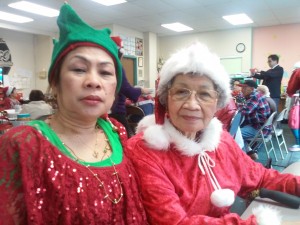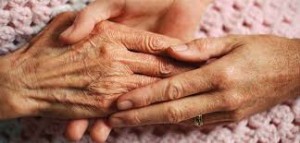
Caregiver Aida Tolop, left with her care recipient, retired dentist Maria Comoda. PHOTO BY JUN NUCUM
SAN FRANCISCO—It’s a sharp contrast from early last spring, after the seniors had attended a seminar on end-of-life issues in wheelchairs, walkers and canes. This time older Filipino immigrant dressed in their Christmas best stream in, ready to party with their friends, the regulars at the Thursday morning senior program at West Bay Pilipino Multi Service Center.
Assistive devices now deposited by the door, the festivities begin, as always, with prayer. Laughter accompanies noodles, egg rolls, cake and coffee, consumed between Filipino Christmas songs, dancing and a gift exchange.
Seniors become somber
Conversation, though, become sombers, centered around death and dying.
One of the West Bay Pilipino regulars, Aida Tolop, a care provider in her forties, shares with the group her traumatic experience with a past, now-deceased care recipient.
The man was transferred to hospice care, just a day after she rushed him to hospital for a urinary tract infection. Being in hospice “was like he was being killed little by little,” she says, with unmasked horror on her face.
When she visited her ward the next day, Tolop says she was shocked to see that her care recipient was taken off his oxygen tank and was being administered morphine to alleviate pain. The infection had developed into sepsis, hospice care providers told Tolop.
She says they told her they administered the pain medication “because he was old anyway, and that the infection had spread to his bloodstream.”
But the patient’s family members, who were coming in from other states, were never consulted, Tolop says. “I didn’t know if he really had lost all chances of surviving.” By the time the man’s relatives arrived, the patient was unconscious and could no longer communicate.

The family reacted with sad resignation, she recalls, saying the doctors were the experts. Tears flow down Tolop’s face as she remembers the moment her care recipient finally died.
Confusion on Catholic teachings
Tolop’s story sparks a shouting match. Another elderly woman, a staunch Catholic, stands up and chimes in, warning the others to never go into hospice care, or to receive palliative care, insisting these are mere pretexts to assisted suicide.
Citing Catholic beliefs, she points out that it is a mortal sin to willfully end life, and that unrepentant mortal sinners are doomed to eternal damnation. In response, a World War II veteran scolds Tolop and the woman for bombarding their colleagues with fear and guilt.
Yet the Catholic senior’s statements illustrate some of the most common, but understandable, confusion over end-of-life issues and terminology, even in the general population.
Catholic experts in the field of palliative care succinctly draw the distinction between palliative care and assisted suicide or euthanasia (so-called mercy killing) through the slogan: “Kill the pain. Not the patient.”
Palliative care “kills the pain” and seeks to show compassion to those who may or may not be terminally ill by providing pain alleviation, without hastening or bringing about death.
Patients can receive it to ease pain and provide comfort at any time, at any stage of illness, whether it be terminal or not. And it can be administered at home, according to the National Caregivers Library.
Hospice care is generally provided to patients considered to be terminal or within six months of death.
But perhaps the deeper confusion resides in the superstition-riddled and often non-doctrinal, traditional Filipino Catholic morality that appears to conflate suffering and pain with holiness. The Philippines, the third largest Catholic country in the world, is deeply conservative.
It’s in this narrow context that a number of Filipino Catholics might view end-of-life issues: It is God’s decision, not man’s, to end life. Suffering through pain is equated with Jesus-like martyrdom as atonement for sin, best exemplified by Filipino Catholic penitents’ extreme custom of bloody self-flagellation and crucifixion, literal reenactments of the biblical Christ’s own end-of-life story.
Not always God’s will
But pain and suffering do not always necessarily reflect God’s will, stresses Vincent Nguyen, MD, Board Certified Hospice and Palliative Care Specialist.
Nguyen describes himself as a “cradle Catholic,” born and raised in the Roman Catholic tradition. “People overall who do this [hospice and palliative care], do the work of God,” he said.
Nguyen works with spiritual leaders, including Roman Catholic priests, to train them in dealing with families confronted with tough questions on death and dying. “Not every single priest is trained on end-of-life issues,” he notes. He also speaks to several leaders about teaching seminarians, the future priests.
“Within the Catholic teaching, we are on a journey in this world for a mission, and when we’re done with our work, God will call us home.” Nguyen says. “We are open to life, we are open to death. We know life is a gift, and we will do everything to stay alive.”
But Nguyen admits that life-sustaining technology can be both a blessing and a curse. “We want to pray for curative healing, and God will answer prayers. But we also pray for wisdom to see if [the technology] is prolonging life or prolonging the process of dying.”
“If the treatment is more harmful than the intended benefit, it needs to stop. That is within the Catholic church’s teaching,” he explains.
The role of palliative care, Nguyen believes, is to journey with the family. “It’s not a determination whether we want to keep someone alive. The person is already dead (except for the technology).” He urges Catholic families in end-of-life situations to seek their priest’s advice.
Advance directives
Advance directives are documents that can spare families the agony of decision-making on behalf of a loved one who has fallen sick.
According to the National Hospice and Palliative Care Organization, an advance directive names a person’s legal health care representative and spells out instructions for a person’s future life-sustaining treatments, should the person be unable to make medical decisions on his own behalf, as was the case with Tolop’s former care recipient. It is recommended for all adults, 18 and older, regardless of their health status.
But wouldn’t an advance directive effectively preempt God’s will and possibly violate Catholic doctrine? Filipino priest Father Geoffrey Baraan of the Saint Anne Catholic Church in Union City, Calif., clarifies the Church’s stance: “The teaching of the Church is selective advance directive.”
Baraan explains that while the Catholic Church allows the faithful to spell out their end-of-life preferences in advance, their directives must not go against Catholic prohibitions.
He states that patients “will not be allowed to be totally abandoned after the life-support machine is taken out. Total deprivation, so as not to let the person die naturally, is not approved. Merciful killing and euthanasia are not allowed.”
However, Baraan says, “The church approves even the removal of life support machines, if the person continues to receive necessary medication, sustenance and comfort care to let him die naturally. The operative word is still naturally.”
Customs hard to change
A 2013 report of the California HealthCare Foundation warns of the serious consequences of not executing advance directives: “Some patients fail to receive desired treatment, while many others receive unnecessary or unwanted procedures. This puts them at risk for infection, pain, and time away from loved ones in their final weeks and days.”
The same study shows that 70 percent of Californians surveyed preferred to die at home than in a hospital or hospice. Also, two-thirds did not want their families burdened by the cost of care.
Seniors at San Francisco’s West Bay Pilipino Multi Service Center said they share these preferences after receiving information on end-of-life issues and advance directive forms early last spring. But by the Christmas season, most of them still hadn’t taken action.
Antonietta Villareal is relying on her children to make the decisions for her, should the time come when she cannot. “I have four kids here in America, and they’ll decide what to do with me,” she says. “I haven’t really shared any preferences with them, not even verbally.” She does however express a wish for her remains to be cremated and brought back to the Philippines.
Juana Paylano has told her children not to prolong her life, should she be in a situation that warrants that kind of choice: “That’s just verbal. There’s nothing written.” Her big concern is that her death not be a financial burden to her children—she’s even set aside a fund to pay for her funeral and burial costs.
Maria Comoda says she’s not in the right frame of mind yet to fill out her advance directive, even if she knows she has to do one.
“You have to make an advance directive while still active,’ my son reminded me the other night,” Comoda says. “I might just leave it up to my son to do it.” She adds, “I’ll still live long. I pray to God I will still live longer.”
There’s a phrase in the Tagalog, the main Filipino language, that describes this fatalistic attitude: Bahala na. It means, “Just leave it to God.”
However, some seniors, like Angie Bagares, did complete advance directives. “We had a friend who didn’t have an advance directive,” Bagares says. “She slipped, hit her head and became comatose. She has no relatives here. That’s tough. She never woke up. So an advance directive is really important.”
Vivian Zalvidea Araullo is the executive director at West Bay Pilipino Multi Service Center, a San Francisco nonprofit that serves Filipino immigrants and other communities of color. Zalvidea Araullo, a multi-awarded broadcast and print journalist, wrote this article for Inquirer.net through a New America Media journalism fellowship sponsored by the California Health Care Foundation. Contact her at Vivian@westbaycentersf.org ; with additional reporting by INQUIRER.net correspondent Jun Nucum.
RELATED STORIES
Immigrants rely on God, family, home in making end-of-life decisions
More Filipino Americans will need palliative care

